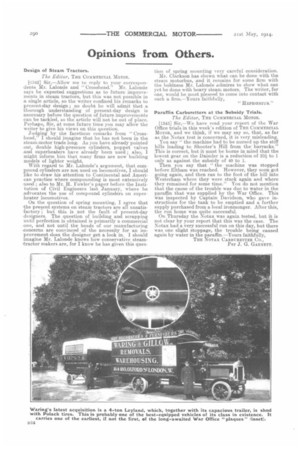Opinions from Others.
Page 22

If you've noticed an error in this article please click here to report it so we can fix it.
Design of Steam Tractors.
The Editor, THE COMMERCIAL MOTOR.
E1342] Sir,—Allow me to reply to your correspondents Mx. Lalonde and "Crosshead." Mr. Lalonde says he expected suggestions as to future improvements in steam tractors, but this was not possible in -a single article, so the writer confined his remarks to present-day design ; no doubt he will admit that a thorough understanding of present-day design is necessary before the question of future improvements can be tackled, so the article will not be out of place. Perhaps, Sir, at some future time you may allow the 'writer to give his views on this question. Judging by the facetious remarks from "Crosshead," I should imagine that he has not been in the steam-motor trade long. As you have already pointed out double high-pressure cylinders, poppet valves and superheaters have already been used ; also, I might Inform him that many firms are now building models of lighter weight. With regard to Mr. Lalonde's argument, that compound cylinders are not used on locomotives, I should like to draw his attention to Continental and American practice where compounding is most extensively -used ; also to Mr. If. Fowler's paper before the Institution of Civil Engineers last January, where he advocates the use of compound cylinders on super-heater locomotives.
On the question of spring mounting, I agree that the present systems on steam tractors are all unsatisfactory; but this is not the fault of present-day ,designers. The question of building and scrapping until perfection is obtained is primarily a commercial one, and not until the heads of our manufacturing -concerns are convinced of the necessity for an improvement does the designer get a look in. I should imagine Mr. Lalonde knows how conservative steamtractor makers are, for I know he has given this ques
tiori of spring mounting very careful consideration.
Mr. Clarkson has shown what can be done with the steam motorbus, and it remains for some firm with the boldness Mr. Lalonde admires to show what can yet be done with heavy steam motors. The writer, for one, would be most pleased to come into contact with such a firm.—Yours faithfully,
" HEPHCESTUS."
Paraffin Carburetters at the Subsidy Trials.
The Editor, THE COMMERCIAL MOTOR.
[1343] Sir,—We have read your report of the War Office trials in this week's edition of TEE COMMERCIAL MOTOR, and we think, if we may say so, that, as far as the Notax test is concerned, it is very misleading.
You say "the machine had to be nursed up the stiff hills leading to Shooter's Hill• from the barracks." This is correct, but it must be borne in mind that the lowest gear on the Daimler is a reduction of 23i to 1 only as against the subsidy of 90 to 1.
Then you say that "the machine was stopped before Eltham was reached. However, they soon got going again, and then ran to the foot of the hill into Westerharn where they were stuck again and where they remained for some time." You do not mention that the cause of the trouble was due to water in the paraffin that was supplied by the War Office. This was inspected by Captain Davidson, who gave instructions for the tank to be emptied and a further supply purchased from a local ironmonger. After this, the run home was quite successful. On Thursday the Notax was again tested, but it is not clear by your report that this was the case. The Notax had a very successful run on this day, but there was one slight stoppage, the trouble being caused again by water in the paraffm.—Yours faithfully, THE NOTAX CARBURETTER CO., Per J. G. GARNETT.


























